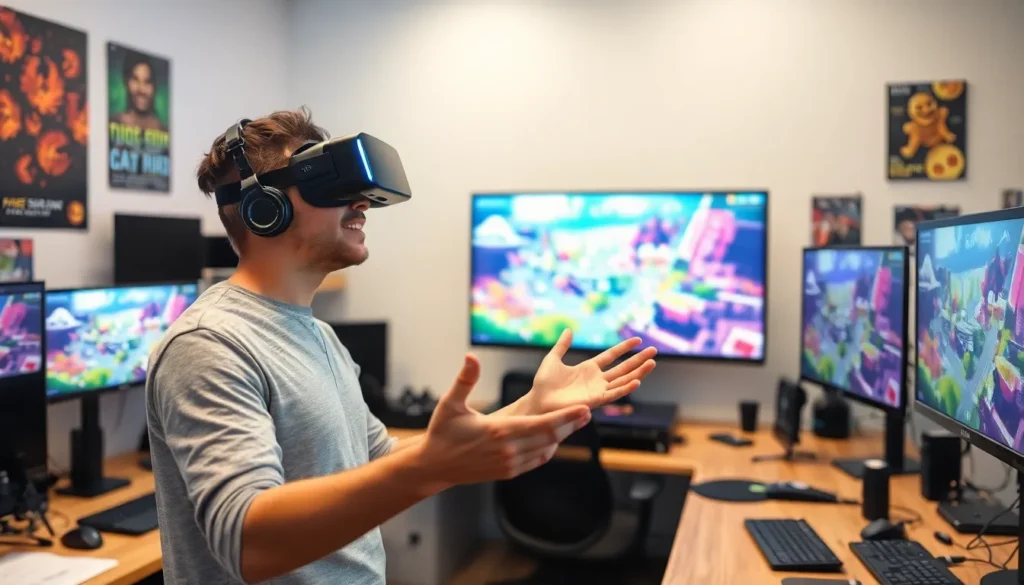The metaverse is no longer just a buzzword tossed around by tech enthusiasts; it’s a digital universe bursting with potential. Imagine a world where players can build, explore, and interact in ways that make traditional gaming feel like a warm-up lap. As developers dive headfirst into this virtual playground, the opportunities are as limitless as a rogue NPC on a quest for glory.
Creating games in the metaverse isn’t just about coding; it’s about crafting experiences that blend creativity with cutting-edge technology. Think of it as a digital buffet where players can feast on everything from immersive storytelling to jaw-dropping graphics. So, buckle up and get ready to explore the wild world of metaverse game development, where the only limit is your imagination—and possibly your caffeine intake.
Overview of Metaverse Game Development
Metaverse game development involves creating games designed for immersive, interactive digital environments. Developers focus on integrating various technologies such as virtual reality, augmented reality, and blockchain to enhance user experience. Creativity drives this process, as developers craft engaging narratives and stunning visuals to captivate players.
Designing for the metaverse requires collaboration among artists, programmers, and designers. Teams utilize game engines like Unity or Unreal Engine, which support complex graphics and real-time rendering. Additionally, game developers must consider player interactions and social dynamics, fostering communities within these digital spaces.
The process involves extensive planning and prototyping. Developers often create virtual worlds that allow extensive player exploration and engagement. They incorporate elements like NFTs for asset ownership, providing players with tangible rewards in the virtual realm.
Understanding user experience is crucial. Developers gather feedback and iterate on their designs to meet player expectations. Adaptability plays an important role in this rapidly evolving sector, with trends changing frequently.
As technology advances, metaverse game development looks set to expand. Innovations aim at enhancing realism and interactivity to boost player immersion. Future developments may lead to more seamless integration of physical and digital experiences, enhancing the metaverse’s allure.
Studying market trends and player preferences serves crucial as developers navigate this landscape. Effective strategies often emerge from analyzing competitor offerings and understanding what attracts players to specific games. Aligning with user demand can significantly influence a game’s success in the metaverse.
Key Technologies in Metaverse Game Development

Metaverse game development relies on several key technologies, creating immersive and interactive experiences for players. These technologies redefine how games engage users and enhance online interactions.
Virtual Reality (VR)
Virtual reality plays a critical role in metaverse game development. Using VR headsets, players immerse themselves in three-dimensional environments that feel real. This technology allows for an in-depth exploration of digital worlds, enhancing user engagement. Developers create interactive experiences through VR by incorporating realistic graphics and physics simulations. Engaging players in social interactions within VR environments forms another crucial aspect. This dynamic connection fosters a sense of presence, making users feel part of a larger community.
Augmented Reality (AR)
Augmented reality enhances the gaming experience by merging the real world with digital elements. Players enjoy interactive gameplay involving both physical and virtual aspects. AR technology enables users to see game objects overlaid on their real surroundings, creating a unique interaction. Developers utilize devices like smartphones and AR glasses to reach diverse audiences, expanding the user base. By employing location-based features, AR supports gameplay that encourages exploration of players’ environments. Therefore, AR contributes significantly to building immersive worlds in the metaverse.
Blockchain Integration
Blockchain integration offers enhanced security and transparency in metaverse gaming. This technology allows for the creation of digital assets, such as non-fungible tokens (NFTs), which provide ownership verification. Players can buy, sell, and trade these assets, increasing their value and retaining a sense of ownership. Developers leverage blockchain to create decentralized ecosystems, fostering player-driven economies. Additionally, smart contracts enable automated transactions, streamlining game mechanics. As a result, blockchain not only enhances trust but also encourages innovation within metaverse game development.
Game Design Principles for the Metaverse
Game design in the metaverse emphasizes user engagement and immersive experiences. Developers focus on principles that enhance player interaction and creativity.
Player-Centric Design
Player-centric design prioritizes the needs and preferences of users. Understanding what players enjoy boosts satisfaction and encourages longer play sessions. Game mechanics should empower players, offering choices that affect gameplay. Challenges should be balanced to maintain engagement without causing frustration. Incorporating social features fosters community building, allowing players to connect and collaborate. Feedback systems enable developers to refine experiences based on player input, ensuring constant evolution of the game world.
Immersive World-Building
Immersive world-building creates engaging environments that captivate players. Crafting detailed, rich landscapes enhances exploration and discovery. Dynamic weather systems and day-night cycles add realism to gameplay, making virtual worlds feel alive. Story elements integrated into the environment deepen narrative connections, drawing players into the experience. Interactivity should extend beyond core mechanics, inviting players to influence and transform their surroundings. Integrating sound design and music enhances atmosphere, enveloping players in a captivating audio experience.
Challenges in Metaverse Game Development
Creating engaging experiences in the metaverse introduces complex challenges. Developers face numerous hurdles that demand innovative solutions.
Technical Challenges
Developers encounter significant technical challenges when building metaverse games. Limited bandwidth and latency issues can disrupt player experiences, especially in real-time interactions. Integrating new technologies like VR and AR often requires extensive optimization to ensure smooth performance. Additionally, scaling environments to accommodate a growing user base while maintaining high-quality graphics proves difficult. Security also plays a critical role as developers strive to protect user data and digital assets from potential breaches. Ensuring compatibility across diverse devices adds another layer of complexity, necessitating thorough testing to guarantee seamless user experiences.
Legal and Ethical Concerns
Legal and ethical concerns impact metaverse game development significantly. Developers must navigate a landscape of copyright issues when using existing intellectual properties or creating new assets. User privacy deserves careful consideration since players increasingly share personal information within digital environments. Content moderation becomes essential as developers strive to create safe spaces free of harassment or toxicity. Involving community stakeholders fosters a sense of ownership and responsibility, ensuring that developers address social implications of their games. Striking a balance between innovation and adherence to regulations remains a top priority for developers in the evolving metaverse landscape.
Future Trends in Metaverse Game Development
Emerging trends in metaverse game development focus on enhanced realism and user immersion. Developers increasingly leverage artificial intelligence to create adaptive game environments that respond to player actions. The infusion of machine learning algorithms allows for dynamic storytelling, adjusting narratives based on individual choices.
Growing interest in user-generated content also shapes future developments. Players contribute directly to game worlds by designing levels and assets, creating unique experiences. This community-driven approach fosters engagement, encouraging players to explore and contribute creatively.
Blockchain technology continues to play a pivotal role in the metaverse. Its use extends beyond digital asset ownership, enabling decentralized gaming economies where players can trade, buy, and sell in-game items securely. This shift not only enhances player investment but also encourages lasting connections within gaming communities.
The integration of cross-platform play enhances accessibility and fosters interaction among diverse user groups. Players can seamlessly transition between devices, ensuring a cohesive experience whether they use VR headsets or smartphones. This trend supports the growth of larger gaming communities that thrive on social interaction.
Metaverse game developers prioritize creating sustainable ecosystems that support long-term player engagement. They utilize feedback loops to gather player insights, adjusting gameplay elements accordingly. These iterative processes enhance user satisfaction, leading to more profound connections with the game.
Research into virtual reality and augmented reality technologies continues to advance. Such developments pave the way for more immersive experiences, where players engage in breathtaking environments that blend the physical and digital worlds. Innovative applications of these technologies redefine gameplay mechanics, captivating audiences in unprecedented ways.
By focusing on these trends, metaverse game developers position themselves at the forefront of the industry, driving forward the evolution of gaming experiences that resonate with players worldwide.
Conclusion
Metaverse game development stands at the intersection of creativity and technology. As developers embrace innovative tools and techniques, they’re crafting experiences that captivate players and foster vibrant communities. The landscape is dynamic and ever-evolving, requiring adaptability and a keen understanding of user preferences.
By leveraging virtual reality, augmented reality, and blockchain technology, developers can create immersive worlds that resonate with audiences. The emphasis on player-centric design and community engagement ensures that games not only entertain but also build lasting connections.
As the metaverse continues to expand, the potential for groundbreaking developments is limitless. Those willing to explore this frontier will find themselves at the forefront of a transformative era in gaming.



